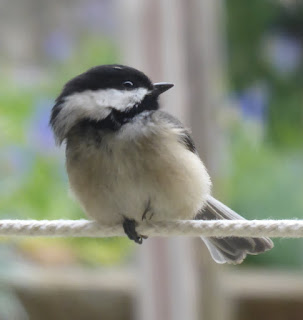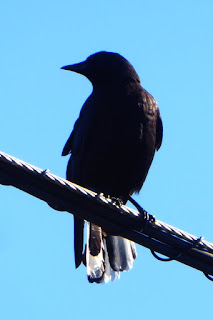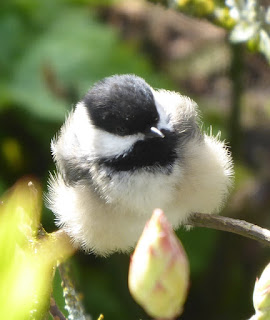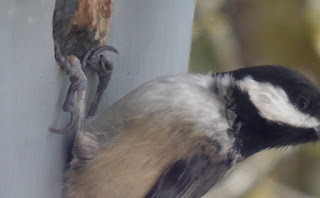 My pal Julie Zickefoose is a world-class noticer. One of the cool things you can do if you’re a world-class noticer like Julie is you can learn things that nobody else knows yet. It’s not like everything knowable is out there on the web somewhere already, ready to be rolled out on casters.
My pal Julie Zickefoose is a world-class noticer. One of the cool things you can do if you’re a world-class noticer like Julie is you can learn things that nobody else knows yet. It’s not like everything knowable is out there on the web somewhere already, ready to be rolled out on casters.
Ornithologists like to follow individual birds to see what they’re up to, where they’ve been, and where they think they’re going this time of night, Missy. They do this by nabbing them in nets and sewing little tags in their underwear. Sometimes they nab the same bird in subsequent years and eventually they know how old they are without having to saw into their tiny legs and count the rings. Or maybe someone else nabs them 10,000 miles away and we know how far they flapped for fruit, and then later know they came right back to the same original dang tree to nest. Cool stuff, although it’s a long shot you’re going to learn anything about any particular bird. It takes a lot of luck with your nabbing.
 But Julie pays fierce attention to her own homies. Sometimes it’s easy for her to recognize them–a doe whose eyes are hooked up crooked, for instance, or a blue jay with missing feathers or a mustache. But she’s so good at paying attention that she doesn’t need anything that obvious. She can tell critters apart because of how they ack. One bluebird will distinguish himself from the flock by his tendency toward solipsism, for instance, which gives him–to Julie’s observant eye–an air of skepticism that sets him apart. She’ll not only know which cardinal winks, but whether it’s an affectionate or conspiratorial wink. Probably affectionate. She goes out on a limb for them, as it were.
But Julie pays fierce attention to her own homies. Sometimes it’s easy for her to recognize them–a doe whose eyes are hooked up crooked, for instance, or a blue jay with missing feathers or a mustache. But she’s so good at paying attention that she doesn’t need anything that obvious. She can tell critters apart because of how they ack. One bluebird will distinguish himself from the flock by his tendency toward solipsism, for instance, which gives him–to Julie’s observant eye–an air of skepticism that sets him apart. She’ll not only know which cardinal winks, but whether it’s an affectionate or conspiratorial wink. Probably affectionate. She goes out on a limb for them, as it were.
Even I can do it if it’s easy enough. We have a crow a couple miles away with two white tail feathers and we’ve gone back for three years to check on him, and he’s always in the same tree. We think it’s right handy of him to be so recognizable. And I have also learned some things, by noticing, that are not in the books. For instance: robins fart. The literature says they don’t, but they do, and I’ve seen ’em do it. But mainly I can’t pick out individuals in a flock. Marge and Studley Windowson, my chickadees, to take an example, are i-stinkin’-dentical. They don’t even know who they are until an egg drops out of one of them.
UNTIL THIS YEAR! GREAT NEWS! I can tell Marge and Studley apart!
SHITTY NEWS! It’s because Studley’s got a bum foot!
 I saw him a few weeks ago and thought he was feeling po’ly. He was all flopped over and fluffed out on a twig the way birds get when they’re sick. But he flew off for sunflower seeds like anything, and ate, and flew up into tall trees, and generally acted fine. Later I saw him checking out our bird house and could see that one foot was all balled up in a little knob and he had to hang from the other one. Marge was inside hammering away on her nest. We’ll trust The Literature that the female builds the nest, and that’s how I know Studley’s the one with the crumpled gam. And now I can really observe who does what for the next month and a half. I’m very excited.
I saw him a few weeks ago and thought he was feeling po’ly. He was all flopped over and fluffed out on a twig the way birds get when they’re sick. But he flew off for sunflower seeds like anything, and ate, and flew up into tall trees, and generally acted fine. Later I saw him checking out our bird house and could see that one foot was all balled up in a little knob and he had to hang from the other one. Marge was inside hammering away on her nest. We’ll trust The Literature that the female builds the nest, and that’s how I know Studley’s the one with the crumpled gam. And now I can really observe who does what for the next month and a half. I’m very excited.
 Last year I thought the neighbor cat Sid had gotten Marge or Studley because the nest had been abandoned, and Sid had been stalking them for a while. But maybe Sid only got hold of Studley’s foot. And that put him down for the count for last year’s brood, but he’s back in the pink now. Anyway, Sid is dead. He got run over by a car, which is really sad news for his personal human, but really good news for everyone else around here.
Last year I thought the neighbor cat Sid had gotten Marge or Studley because the nest had been abandoned, and Sid had been stalking them for a while. But maybe Sid only got hold of Studley’s foot. And that put him down for the count for last year’s brood, but he’s back in the pink now. Anyway, Sid is dead. He got run over by a car, which is really sad news for his personal human, but really good news for everyone else around here.
I was wondering how the Windowsons were doing. It's reassuring that Studley was able to bounce back from his injury. Chickadees are tough little birds!
We could not be prouder of the Windowsons. Dave's worked as hard as they have, but I haven't.
The detail got a little hazy at the end there… 'run over by a car'? No names, no pack drill?!
Now, let's not be suspicious. Sid's mom even allowed as how she thought I might have trapped him once (he was trapped by another altogether more devious neighbor), but even then, she said she wouldn't have blamed me. That was cool, marginally. Still didn't take the dude indoors. And now look.
So glad to hear the Windowsons' deaths were only alleged! I've been mourning for you ever since reading that post, and sharing your anger about the neighbor's 'it's undignified' attitude about Sid.
Looks as though Studley's leg got twisted 180 degrees and healed up that way. He's probably not wasting time and energy feeling sorry for himself, so I shan't either. I'm just so tickled that they're back!!
Well, it wasn't Sid's owner with that attitude (I went back to June 2017 and reread that post), but the attitude was what rankled, regardless of which cat's owner held it!
You are the A-Number-One mostest avidest Murrmurrs follower. You are. I think the next time I wonder "didn't I already write about that?" I'll call you up to see. It's not like I remember.
Do Marge and Studley know they are making egg drop soup? That is how it's done, right?
Pretty sure that's how it's done, yes.
"Sewing little tags in their underwear" – ha ha ha!
Credit the amazing Mary Ann.
Hurray for Marge and Studley! And I won't be mourning Sid any more than you are. It's too bad that cats have to pay the price for their owners' stupidity, but there you go.
Sid's owner was always kind of morose about the whole project, but she simply. Couldn't. I wonder if she'll do better by her next kitten. Sid was really cute and I would have loved him in a whole different context.
Have you tried making little crutches for Studley?
Would I have to knit them out of steel wool? In which case, no.
We have a couple of birds with a foot screwed up into that little ball. I am sorry for them. Much more sorry than they seem to be.
They're damned resilient.
Solipsistic birds are notoriously easy to pick out, I've heard.
Still just a rumor…
For the 3rd spring in a row, a very recognizable pair of California Towhees is in my garden every day. Recognizable because one of the two is missing a foot entirely. She seems to manage fine and her partner obviously thinks she is sexy as the dickens even without that appendage, as they've been pretty flagrant about showing…ahem…affection.
SO MUCH…AFFECTION!
Awww! I don't see your posts until I get the email (9 pm May 2). And I allus click on 'em. And there I am! How sweet! I am thrilled you can tell Marge and Studley apart, but less than thrilled at the reason. I also notice that Studley's good foot has an issue as well. It's swollen; the near toe and especially the middle joint of the middle toe. Now, perhaps this is from overuse because the other one is useless. But I worry about a bacterial infection. How to get an antibiotic to Studley? Let me ask: are you feeding anything other than sunflower? Any Zick dough, anything like that? Because gout is also a possibility. So many possibilities. Keep me in the loop!
Darlin', there isn't a loop I want to be in without you in it. That last picture of Studley is the best I could do for now but it's fuzzy. If you're talking about his left foot, that's the bad one. I almost thought I saw a remnant of a bird band. He recently started using his bad foot sometimes to hang from the hole. I don't give him anything but sunflowers and love, but I'd sure be pleased to offer him some Zick dough with an antibiotic (from the vet?) GOUT! I thought that was just for old men with drinking problems! I'll try to get a clearer photo.
We are closely watching a pair of bluebirds and wondering if bluebirds in general are possibly evolving a bit into somewhat more assertive personalities. I had just evicted the dang house sparrow nest from the bluebird box, when Mr. & Mrs. Bluebird arrived with apparent joy. They first peered into the doorway, then hopped up top. They seemed to be dancing on the roof of the birdhouse,flapping wings and chattering away right to one another. They truly appeared to be having a very happy conversation, and as the sparrow tried again and again to reclaim the house, the bluebirds repeatedly drove him off. It was quite a scene. We were cheering for the bluebirds!
It would make sense that over the generations, the more assertive bluebirds would be the ones more likely to breed successfully.
Our other bluebird house has 4 lovely blue eggs in it. No sparrows. It's closer to the woods and they seem to leave it alone.
I'm going to quote from my own bird book right here: "Now pretty near everybody of any spiritual worth has a couple of bluebird houses up."
Thank for providing good information for site,Thanks for your sharing.
หนังออนไลน์